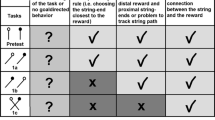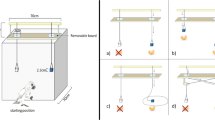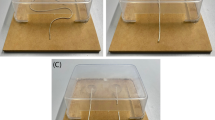Abstract
There are simple co-occurrences as well as functional relationships between events. One may assume that animals detect and use causation rather than mere co-variation. However, understanding causation often requires concepts of hidden forces. In string pulling, obstacles may hamper the access to food. Here, I studied whether ravens have an abstract concept of effort. First, in a competitive situation, ravens (Corvus corax) could choose one out of two strings. The strings differed in whether they were baited with meat and in how far away the meat was. Ravens pulled mainly the string containing meat and where the meat was nearer to the perch, respectively. Second, ravens could choose between two strings that had either a functional obstacle or a non-functional obstacle. Optimal performance required the integration of at least two cues: object and height. In 5 ravens, the model that best matched behaviour took into account only that meat was on a string, ignoring the obstacle. However, 2 ravens’ performance was best explained by a model that took into account both an object’s identity (meat or wood) and its height on the string. Third, one string out of two was loaded with a heavy meat piece. In this overloaded string condition, 5 out of 7 ravens did not try to pull the heavy meat piece but went straight for pulling the smaller piece. The pattern of results indicated that ravens can judge the effort required to pull a string.
Similar content being viewed by others
Notes
The pandanus tools are used to retrieve invertebrates from trees. Insertion of something and pulling it out is common to both the natural and the trap-tube task. Letting something fall has no parallel in the NC crows’ natural environment.
This result holds even if it is based on all 62 trials and 18 errors, because bird N and C never made an error.
The inter-rater reliability for the duration was 0.96 and for the type of string pulled 1. Rater two scored one session per day and bird for experiment 2, n = 33.
References
Betsch T, Haberstroh S, Molter B, Glockner A (2004) Oops, I did it again—relapse errors in routinized decision making. Organ Behav Hum Decis Process 93:62–74
Brown MF (1990) The effects of maze-arm length on performance in the radial-arm maze. Anim Learn Behav 18(1):13–22
Bugnyar T, Heinrich B (2005) Ravens, Corvus corax, differentiate between knowledgeable and ignorant competitors. Proc R Soc B Biol Sci 272:1641–1646
Bugnyar T, Kotrschal K (2004) Leading a conspecific away from food in ravens (Corvus corax)? Anim Cogn 7:69–76
Chittka L, Dyer AG, Bock F, Dornhaus A (2003) Psychophysics—bees trade off foraging speed for accuracy. Nature 424:388
Clayton NS, Dally JM, Emery NJ (2007) Social cognition by food-caching corvids. The western scrub-jay as a natural psychologist. Philos Trans R Soc B 362:507–522
Emery NJ (2009) Cognitive ornithology: the evolution of avian intelligence. Philos Trans R Soc B 361:23–43
Emery NJ, Clayton NS (2004) The mentality of crows: convergent evolution of intelligence in corvids and apes. Science 306:1903–1907
Halsey LG, Bezerra BM, Souto AS (2006) Can wild common marmosets (Callithrix jacchus) solve the parallel strings task? Anim Cogn 9:229–233
Hanus D, Call J (2008) Chimpanzees infer the location of a reward on the basis of the effect of its weight. Curr Biol 18(9):R370–R372
Hanus D, Mendes N, Tennie C, Call J (2011) Comparing the performance of apes (Gorilla gorilla, Pan troglodytes, Pongo pygmaeus) and human children (Homo sapiens) in the floating peanut task. PLoS One 6:e19555
Hare B, Call J, Tomasello M (2004) Chimpanzees are more skillful in competitive than in cooperative cognitive tasks. Anim Behav 68:571–581
Heinrich B (1995) An experimental investigation of insight in common ravens (Corvus corax). Auk 112:994–1003
Heinrich B, Bugnyar T (2005) Testing problem solving in ravens: string-pulling to reach food. Ethology 111:962–976
Hunt GR, Gray RD (2003) Diversification and cumulative evolution in New Caledonian crow tool manufacture. Proc R Soc Lond Ser B Biol Sci 270:867–874
Jones LV, Fiske DW (1953) Models for testing the significance of combined results. Psychol Bull 50:375–382
Kirsch JA, Gunturkun O, Rose J (2008) Insight without cortex: lessons from the avian brain. Conscious Cogn 17:475–483
Koehler DJ, James G (2009) Probability matching in choice under uncertainty: intuition versus deliberation. Cognition 113:123–127
Liedtke J, Werdenich D, Gajdon GK, Huber L, Wanker R (2011) Big brains are not enough: performance of three parrot species in the trap-tube paradigm. Anim Cogn 14:143–149
Martin-Ordas G, Call J, Colmenares F (2008) Tubes, tables and traps: great apes solve two functionally equivalent trap tasks but show no evidence of transfer across tasks. Anim Cogn 11:423–430
Mendes N, Hanus D, Call J (2007) Raising the level: orangutans use water as a tool. Biol Lett 3:453–455
Mulcahy NJ, Call J, Dunbar RIM (2005) Gorillas (Gorilla gorilla) and Orangutans (Pongo pygmaeus) encode relevant problem features in a tool-using task. J Comp Psychol 119(1):23–32
Osthaus B, Lea SEG, Slater AM (2005) Dogs (Canis lupus familiaris) fail to show understanding of means-end connections in a string-pulling task. Anim Cogn 8:37–47
Povinelli DJ (2000) Folk physics for apes: the chimpanzee’s theory of how the world works. Oxford University Press, Oxford
Schrauf C, Call J (2011) Great apes use weight as a cue to find hidden food. Am J Primatol 73(4):323–334.
Schuck-Paim C, Borsari A, Ottoni EB (2009) Means to an end: neotropical parrots manage to pull strings to meet their goals. Anim Cogn 12:287–301
Schwab C, Bugnyar T, Schloegl C, Kotrschal K (2008) Enhanced social learning between siblings in common ravens, Corvus corax. Anim Behav 75:501–508
Seed AM, Tebbich S, Emery NJ, Clayton NS (2006) Investigating physical cognition in rooks, Corvus frugilegus. Curr Biol 16:697–701
Sloman SA (2005) Causal models: how we think about the world and its alternatives. Oxford University Press, New York
Stowe M, Bugnyar T, Loretto M-C, Schloegl C, Range F, Kotrschal K (2006) Novel object exploration in ravens (Corvus corax): effect of social relationships. Behav Process 73:68–75
Taylor AH, Hunt GR, Holzaider JC, Gray RD (2007) Spontaneous metatool use by New Caledonian crows. Curr Biol 17:1504–1507
Taylor AH, Hunt GR, Medina FS, Gray RD (2009) Do New Caledonian crows solve physical problems through causal reasoning? Proc R Soc B Biol Sci 276:247–254
Taylor AH, Medina FS, Holzaider JC, Hearne LJ, Hunt GR, Gray RD (2010) An investigation into the cognition behind spontaneous string pulling in New Caledonian Crows. PLoS One 5:e9345. doi:10.1371/journal.pone.0009345
Tebbich S, Seed AM, Emery NJ, Clayton NS (2007) Non-tool-using rooks, Corvus frugilegus, solve the trap-tube problem. Anim Cogn 10:225–231
Tomasello M (2000) Two hypotheses about primate cognition. In: Heyes CM, Huber L (eds) The evolution of cognition. MIT Press, Cambridge
Visalberghi E, Limongelli L (1994) Lack of comprehension of cause-effect relations in tool-using capuchin monkeys (Cebus apella). J Comp Psychol 108:15–22
Visalberghi E, Néel C (2003) Tufted capuchins (Cebus apella) use weight and sound to choose between full and empty nuts. Ecol Psychol 15:215–228
Visalberghi E, Addessi E, Truppa V, Spagnoletti N, Ottoni E, Izar P, Fragaszy D (2009) Selection of effective stone tools by wild capuchin monkeys. Curr Biol 19:213–217
Weir AAS, Chappell J, Kacelnik A (2002) Shaping of hooks in new Caledonian crows. Science 297:981
Werdenich D, Huber L (2006) A case of quick problem solving in birds: string pulling in keas, Nestor notabilis. Anim Behav 71:855–863
Acknowledgments
I thank the people at the Konrad Lorenz Research station for their support. The work was supported by the Verein der Förderer der Konrad Lorenz Forschungsstelle and the Cumberland Wildpark where the study has been carried out. I also thank B. Pfuhl for video scoring and U. Toelch and R. Biegler for helpful discussions. The paper was greatly improved by the comments and language advice from three anonymous referees.
Author information
Authors and Affiliations
Corresponding author
Rights and permissions
About this article
Cite this article
Pfuhl, G. Two strings to choose from: do ravens pull the easier one?. Anim Cogn 15, 549–557 (2012). https://doi.org/10.1007/s10071-012-0483-0
Received:
Revised:
Accepted:
Published:
Issue Date:
DOI: https://doi.org/10.1007/s10071-012-0483-0




